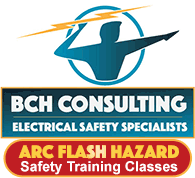Today i want to talk about OSHA and how it relates to NFPA 70e®. The question I always get: Does OSHA require me to protect my employees from arc flashes in accordance with NFPA 70e® or is NFPA 70e® the law?
Let’s talk briefly about arc flashes and their violent nature.
They can produce temperatures up to 35,000 degrees. Employees who are not protected – they’re not wearing the proper clothing and equipment can suffer severe injuries… even death. It is not uncommon for employees who are exposed to arc flashes to really never recover and regain their past quality life.
In some cases these injuries can cost employers up to a million dollars. Certainly OSHA recognizes arc flashes as a workplace hazard. now 1910 Subpart S, which is the general electrical safety law written by OSHA, required by industry, doesn’t really say anywhere in that law that you have to follow NFPA 70e® and I think that’s where some of the confusion comes in.
General Duty Clause: Enforcement of electrical safety violations
(www.osha.gov) There are currently no specific standards for workplace violence. However, under the General Duty Clause, Section 5(a)(1) of the Occupational Safety and Health Act (OSHA) of 1970, employers are required to provide their employees with a place of employment that “is free from recognizable hazards that are causing or likely to cause death or serious harm to employees.” The courts have interpreted OSHA’s general duty clause to mean that an employer has a legal obligation to provide a workplace free of conditions or activities that either the employer or industry recognizes as hazardous and that cause, or are likely to cause, death or serious physical harm to employees when there is a feasible method to abate the hazard.
However what OSHA does say in what is known as the General Duty Clause is that the employer is responsible to find hazards in the workplace that can cause serious harm or even death and you’re required under the General Duty Clause to protect your employees from those hazards. OSHA also requires under 1910 132 that employers protect their employees from hazards that require the use of personal protective equipment (PPE).
Certainly arc flashes producing the violent temperatures that they produce require employees to be wearing PPE they need arc-graded clothing, helmet, gloves… things to protect them from the heat and the other hazards associated with arc flashes.
And this is where NFPA 70e® comes in. By following NFPA 70e® we’re going to understand what arc flash hazards are. We’re going to be able to identify them in the workplace and we’re going to know what personal protective equipment is required to protect our employees from those hazards.
it’s all in the book. So for following all the requirements and NFPA 70e® we’re going to meet all the requirements of the General Duty Clause and we’re also going to meet all the requirements of 1910 132.
BCH Electrical Consulting we’re going to provide you with comprehensive NFPA 70e® electrical safety training we’re going to show you how to use the book to identify the art flash electrical safety hazards in your plant. We’re going to show you how to use the PPE properly. We’re going to show you when it’s required and what level of PPE you need to use and how to maintain it. We’re going to help you avoid OSHA compliance issues and we’re going to show you how to keep your people safe.






